Lyons W.C. (ed.). Standard handbook of petroleum and natural gas engineering.2001- Volume 1
Подождите немного. Документ загружается.

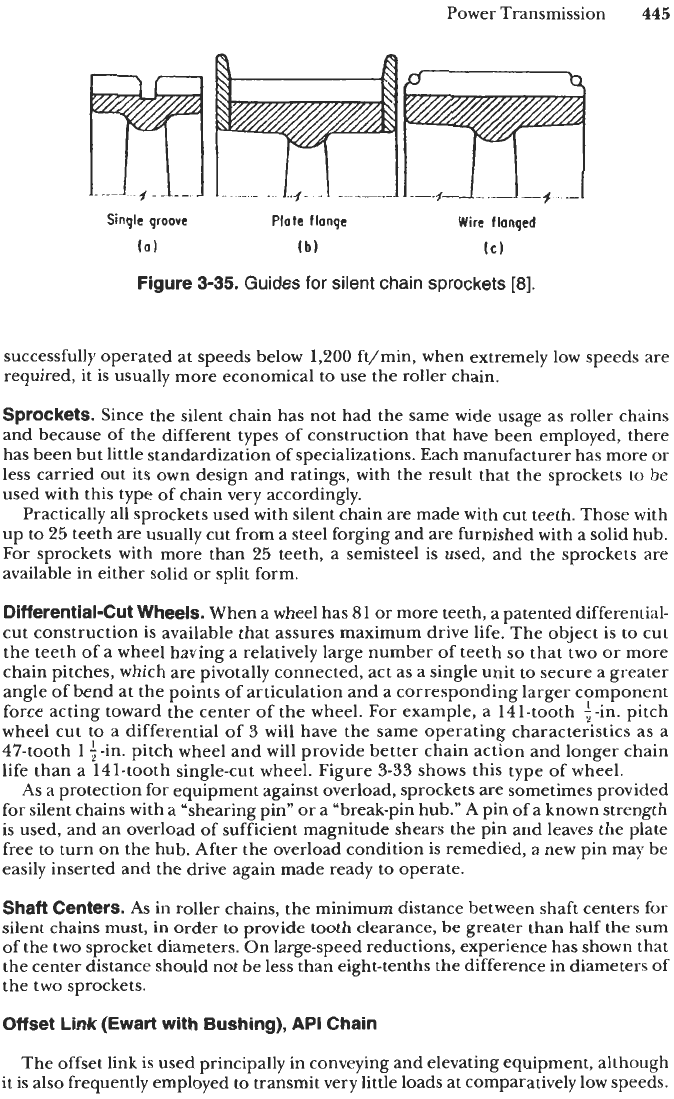
Single
groove
(0)
Power Transmission
445
Plate
flange
Wire
flanged
(b)
(C)
Figure
3-35.
Guides
for
silent
chain
sprockets
[8].
successfully operated at speeds below
1,200
ft/min, when extremely low speeds are
required, it is usually more economical to use the roller chain.
Sprockets.
Since the silent chain has not had the same wide usage as roller chains
and because of the different types of construction that have been employed, there
has been but little standardization of specializations. Each manufacturer has more or
less carried out its own design and ratings, with the result that the sprockets to be
used with this type of chain very accordingly.
Practically all sprockets used with silent chain are made with cut teeth. Those with
up to
25
teeth are usually cut from a steel forging and are furnished with a solid hub.
For sprockets with more than
25
teeth, a semisteel is used, and the sprockets are
available in either solid
or
split form.
Differential-Cut Wheels.
When a wheel has 81 or more teeth, a patented differential-
cut construction is available that assures maximum drive life. The object is to cut
the teeth
of
a wheel having a relatively large number
of
teeth
so
that two
or
more
chain pitches, which are pivotally connected, act as a single unit to secure a greater
angle
of
bend at the points of articulation and a corresponding larger component
force acting toward the center of the wheel. For example, a 141-tooth :-in. pitch
wheel cut to a differential of
3
will have the same operating characteristics as a
47-tooth
1
+-in. pitch wheel and will provide better chain action and longer chain
life than a 141-tooth single-cut wheel. Figure
3-33
shows this type of wheel.
As
a protection for equipment against overload, sprockets are sometimes provided
for silent chains with a “shearing pin” or a “break-pin hub.”
A
pin
of
a known strength
is used, and an overload of sufficient magnitude shears the pin and leaves the plate
free to turn
on
the hub. After the overload condition is remedied, a new pin may be
easily inserted and the drive again made ready to operate.
Shaft Centers.
As
in roller chains, the minimum distance between shaft centers for
silent chains must, in order to provide tooth clearance, be greater than half the sum
of the two sprocket diameters. On large-speed reductions, experience has shown that
the center distance should not be less than eight-tenths the difference in diameters of
the two sprockets.
Offset Link (Ewart with Bushing),
API
Chain
The offset link is used principally in conveying and elevating equipment, although
it is also frequently employed to transmit very little loads at comparatively low speeds.
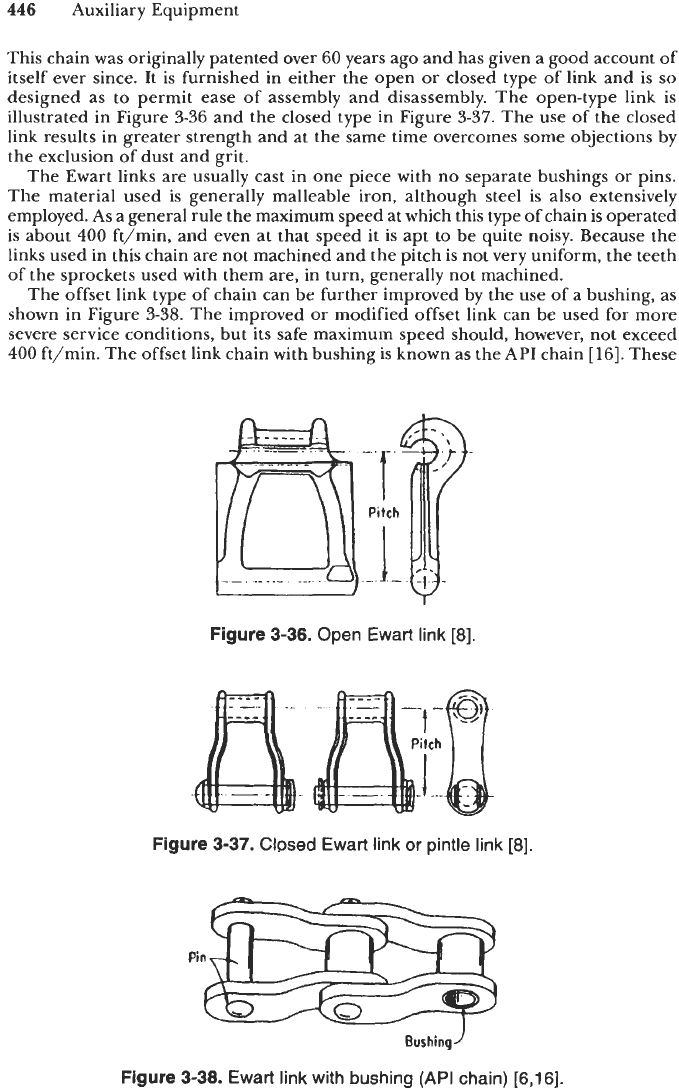
446
Auxiliary Equipment
This chain was originally patented over
60
years ago and has given a good account of
itself ever since. It
is
furnished in either the open
or
closed type of link and is
so
designed as to permit ease
of
assembly and disassembly. The open-type link is
illustrated in Figure
3-36
and the closed type in Figure
3-37.
The use of the closed
link results in greater strength and at the same time overcomes some objections by
the exclusion
of
dust and grit.
The Ewart links are usually cast in one piece with no separate bushings or pins.
The material used is generally malleable iron, although steel is also extensively
employed. As a general rule the maximum speed at which this type of chain is operated
is about
400
ft/min, and even at that speed it is apt to be quite noisy. Because the
links used in this chain are not machined and the pitch is not very uniform, the teeth
of the sprockets used with them are, in turn, generally not machined.
The offset link type of chain can be further improved
by
the use of a bushing, as
shown in Figure
3-38.
The improved or modified offset link can be used for more
severe service conditions, but its safe maximum speed should, however, not exceed
400
ft/min. The offset link chain with bushing is known as the API chain
[16].
These
y-4
.
..
Pitch
Figure
3-36.
Open
Ewart
link
[8].
Figure
3-37.
Closed
Ewart
link
or
pintle link
[8].
BushinqJ
Figure
3-38.
Ewart
link with bushing
(API
chain)
[6,16].
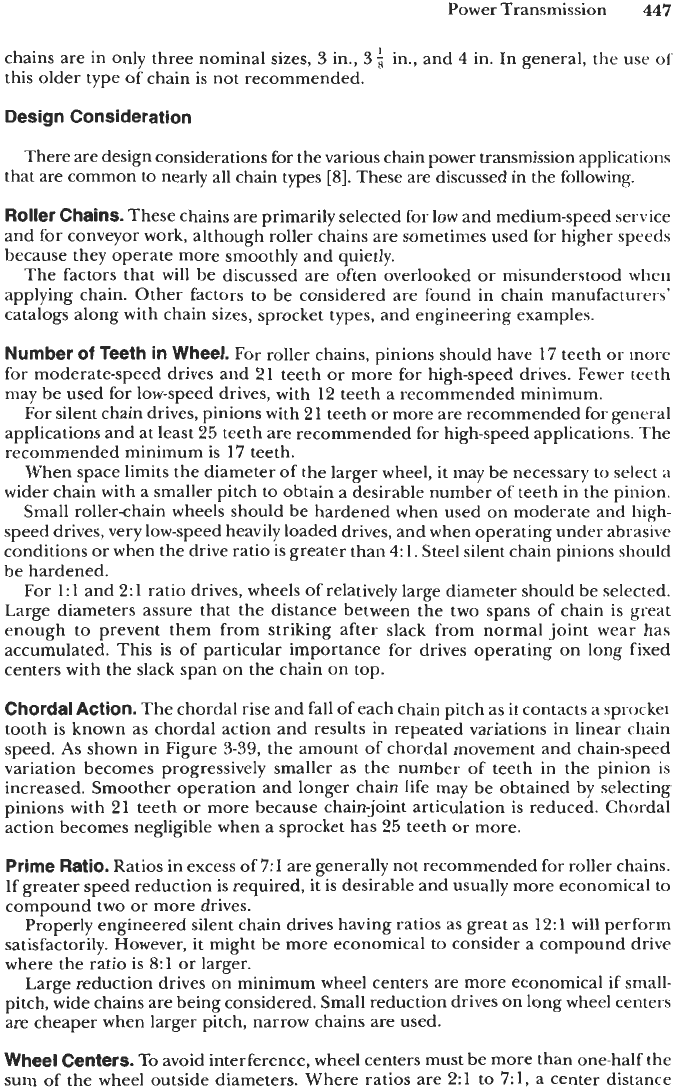
Power Transmission
447
chains are in only three nominal sizes,
3
in.,
3
this older type of chain is not recommended.
Design Consideration
in., and
4
in. In general, the use
of
There are design considerations for the various chain power transmission applications
that are common to nearly all chain
types
[8].
These are discussed in the following.
Roller Chains.
These chains are primarily selected for low and medium-speed service
and for conveyor work, although roller chains are sometimes used for higher speeds
because they operate more smoothly and quietly.
The factors that will be discussed are often overlooked
or
misunderstood when
applying chain. Other factors to be considered are found in chain manufacturers’
catalogs along with chain sizes, sprocket types, and engineering examples.
Number
of
Teeth in Wheel.
For roller chains, pinions should have
17
teeth or morc
for moderate-speed drives and
21
teeth or more for high-speed drives. Fewer teeth
may
be
used for low-speed drives, with
12
teeth a recommended minimum.
For silent chain drives, pinions with
21
teeth or more are recommended for general
applications and at least
25
teeth are recommended for high-speed applications. The
recommended minimum is
17
teeth.
When space limits the diameter of the larger wheel, it may be necessary to select a
wider chain with a smaller pitch to obtain a desirable number of teeth in the pinion.
Small roller-chain wheels should be hardened when used on moderate and high-
speed drives, very low-speed heavily loaded drives, and when operating under abrasive
conditions or when the drive ratio is greater than
4:
1.
Steel silent chain pinions should
be hardened.
For
1:l
and
2:l
ratio drives, wheels
of
relatively large diameter should be selected.
Large diameters assure that the distance between the two spans of chain is great
enough to prevent them from striking after slack from normal joint wear has
accumulated. This
is
of
particular importance for drives operating on long fixed
centers with the slack span on the chain on top.
Chordal Action.
The chordal rise and fall of each chain pitch as
it
contacts a sprocket
tooth is known as chordal action and results in repeated variations in linear chain
speed.
As
shown in Figure
3-39,
the amount of chordal movement and chain-speed
variation becomes progressively smaller as the number
of
teeth in the pinion
is
increased. Smoother operation and longer chain life may be obtained by selecting
pinions with
21
teeth
or
more because chain-joint articulation is reduced. Chordal
action becomes negligible when a sprocket has
25
teeth or more.
Prime
Ratio.
Ratios in excess of
7:l
are generally not recommended for roller chains.
If greater speed reduction is required, it is desirable and usually more economical
to
compound two or more drives.
Properly engineered silent chain drives having ratios as great as
12:l
will
perform
satisfactorily. However, it might be more economical to consider a compound drive
where the ratio is
8:
1
or larger.
Large reduction drives on minimum wheel centers are more economical
if
small-
pitch, wide chains are being considered. Small reduction drives on long wheel centers
are cheaper when larger pitch, narrow chains are used.
Wheel Centers.
To avoid interference, wheel centers must be more than one-half the
sum of the wheel outside diameters. Where ratios are
21
to
7:1,
a center distance
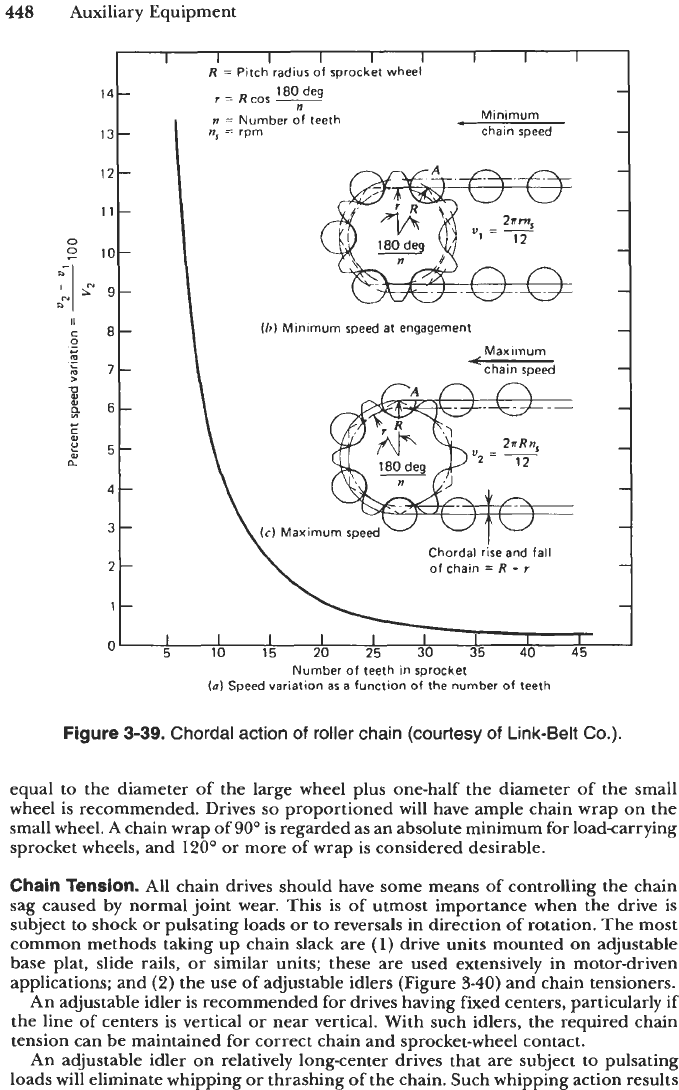
448
Auxiliary Equipment
8
14
13
12
11
0
0
10-
II
c
2
2
P
c
.-
-
C
$
a
-
-
-
-
9-
8-
7-
6-
5-
4-
3-
2-
1-
R
=
Pitchradius o'f sprocket wheel
180
deg
I=
Rcos-
n
=
Number
of
teeth
nr
=
rpm chain speed
Minimum
I
%
5
10
15 20
25 30
35
40
45
(h)
Minimum speed
at
engagement
I
(c)
Maximum sp
Maximum
4chain speed
Chordal
rise
and
fall
of
chain
=
R
-
r
Number
of
teeth in sprocket
(a)
Speed variation
as
a
function
of
the number
of
teeth
Figure
3-39.
Chordal action
of
roller chain
(courtesy
of
Link-Belt
Co.).
equal to the diameter of the large wheel plus one-half the diameter of the small
wheel is recommended. Drives
so
proportioned will have ample chain wrap on the
small wheel.
A
chain wrap
of
90"
is regarded as an absolute minimum for loadcarrying
sprocket wheels, and
120"
or more of wrap is considered desirable.
Chain Tension.
All chain drives should have some means of controlling the chain
sag caused by normal joint wear. This is of utmost importance when the drive is
subject to shock or pulsating loads or to reversals in direction of rotation. The most
common methods taking up chain slack are
(1)
drive units mounted on adjustable
base plat, slide rails, or similar units; these are used extensively in motor-driven
applications; and
(2)
the use of adjustable idlers (Figure
3-40)
and chain tensioners.
An adjustable idler is recommended for drives having fixed centers, particularly if
the line of centers is vertical or near vertical. With such idlers, the required chain
tension can be maintained for correct chain and sprocket-wheel contact.
An adjustable idler on relatively long-center drives that are subject to pulsating
loads will eliminate whipping or thrashing
of
the chain. Such whipping action results
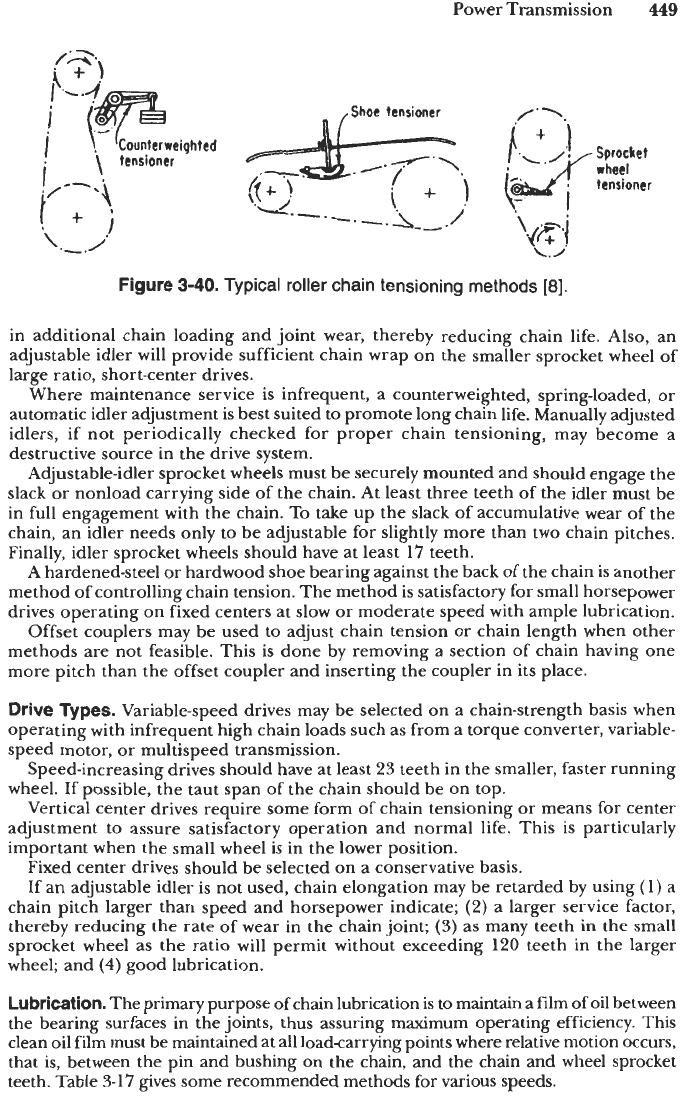
Power Transmission
449
[Counterweighted
!
\
tensioner
I
{Shoe
tensioner
/.-
Figure
3-40.
Typical roller chain tensioning methods
[8].
in additional chain loading and joint wear, thereby reducing chain life. Also, an
adjustable idler
will
provide sufficient chain wrap on the smaller sprocket wheel of
large ratio, short-center drives.
Where maintenance service is infrequent, a counterweighted, spring-loaded,
or
automatic idler adjustment is best suited to promote long chain life. Manually adjusted
idlers, if not periodically checked for proper chain tensioning, may become a
destructive source in the drive system.
Adjustable-idler sprocket wheels must be securely mounted and should engage the
slack
or
nonload carrying side of the chain. At least three teeth of the idler must be
in full engagement with the chain. To take up the slack of accumulative wear of the
chain, an idler needs only to be adjustable for slightly more than two chain pitches.
Finally, idler sprocket wheels should have at least
17
teeth.
A
hardened-steel or hardwood shoe bearing against the back of the chain is another
method of controlling chain tension. The method is satisfactory for small horsepower
drives operating on fixed centers at slow or moderate speed with ample lubrication.
Offset couplers may be used to adjust chain tension or chain length when other
methods are not feasible. This is done by removing a section
of
chain having one
more pitch than the offset coupler and inserting the coupler in its place.
Drive
Types.
Variable-speed drives may be selected on a chain-strength basis when
operating with infrequent high chain loads such as from a torque converter, variable-
speed motor, or multispeed transmission.
Speed-increasing drives should have at least
23
teeth in the smaller, faster running
wheel. If possible, the taut span of the chain should be on top.
Vertical center drives require some form of chain tensioning or means for center
adjustment to assure satisfactory operation and normal life. This is particularly
important when the small wheel is in the lower position.
Fixed center drives should be selected on a conservative basis.
If an adjustable idler is not used, chain elongation may be retarded by using
(1)
a
chain pitch larger than speed and horsepower indicate;
(2)
a larger service factor,
thereby reducing the rate
of
wear in the chain joint;
(3)
as many teeth
in
the small
sprocket wheel as the ratio will permit without exceeding
120
teeth in the larger
wheel; and
(4)
good
lubrication.
Lubrication.
The primary purpose of chain lubrication is to maintain a film of oil between
the bearing surfaces in the joints, thus assuring maximum operating efficiency. This
clean oil film must be maintained at all loadcarrying points where relative motion occurs,
that is, between the pin and bushing on the chain, and the chain and wheel sprocket
teeth. Table
3-17
gives some recommended methods for various speeds.
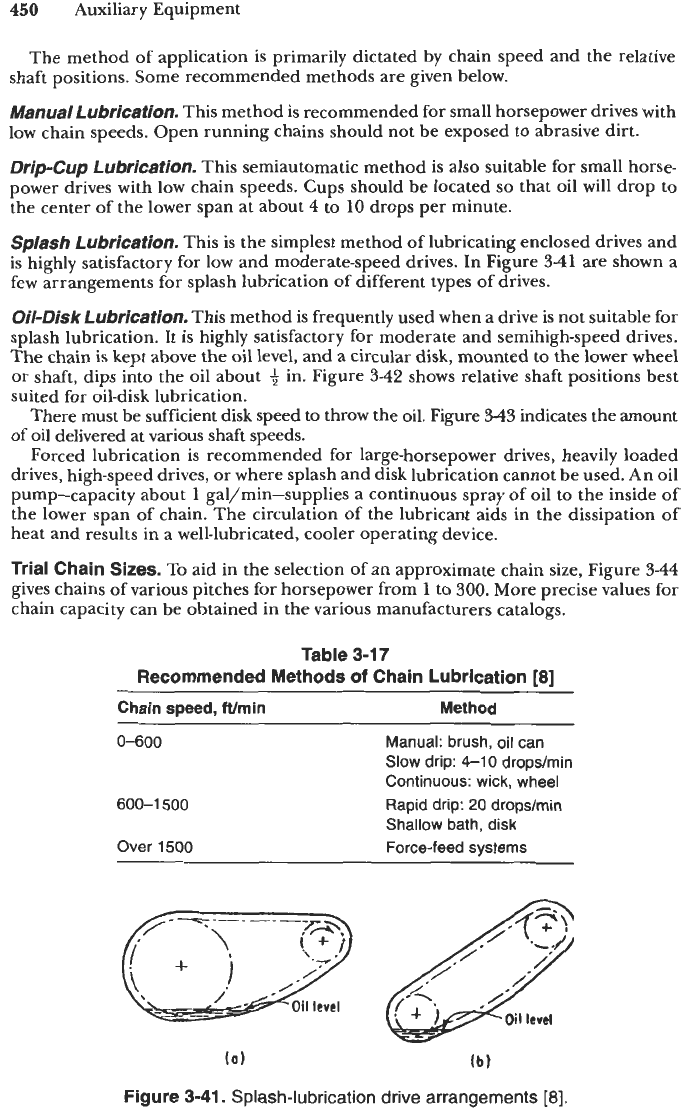
450
Auxiliary Equipment
The method
of
application
is
primarily dictated by chain speed and the relative
shaft positions. Some recommended methods are given below.
Manuai
Lubricafion-
This method is recommended for small horsepower drives
with
low chain speeds. Open running chains should not be exposed to abrasive dirt.
Dripcup
Lubrication.
This semiautomatic method is also suitable for small horse-
power drives with low chain speeds. Cups should be located
so
that oil will drop to
the center of the lower span at about
4
to
10
drops per minute.
Sp/ash
Lubrication.
This is the simplest method of lubricating enclosed drives and
is highly satisfactory for
low
and moderate-speed drives.
In
Figure
3-41
are shown
a
few arrangements for splash lubrication
of
different types of drives.
Oil-DiskLubricafion.
This method is frequently used when a drive is not suitable for
splash lubrication. It is highly satisfactory for moderate and semihigh-speed drives.
The chain is kept
above
the oil level, and
a
circular disk, mounted
to
the lower wheel
or shaft, dips into the oil about
+
in. Figure
3-42
shows relative shaft positions best
suited for oil-disk lubrication.
There must be sufficient disk speed to throw the oil. Figure
3-43
indicates the amount
of oil delivered at various shaft speeds.
Forced lubrication is recommended for large-horsepower drives, heavily loaded
drives, high-speed drives, or where splash and disk lubrication cannot be used. An oil
pump-capacity about 1 gal/min-supplies a continuous spray of oil to the inside of
the lower span of chain. The circulation of the lubricant aids in the dissipation of
heat and results in a well-lubricated, cooler operating device.
Trial Chain Sizes.
To
aid in the selection
of
an approximate chain size, Figure
3-44
gives chains of various pitches for horsepower from 1
to
300.
More precise values for
chain capacity can be obtained in the various manufacturers catalogs.
Table
3-17
Recommended Methods
of
Chain Lubrication
181
Chain
speed,
Wmin
Method
0-600
60&1500
Manual: brush, oil can
Slow drip:
4-10
dropshin
Continuous: wick, wheel
Rapid drip:
20
dropslrnin
Shallow bath, disk
Over
1500
Force-feed systems
(a)
(b)
Figure
3-41.
Splash-lubrication drive
arrangements
[8].
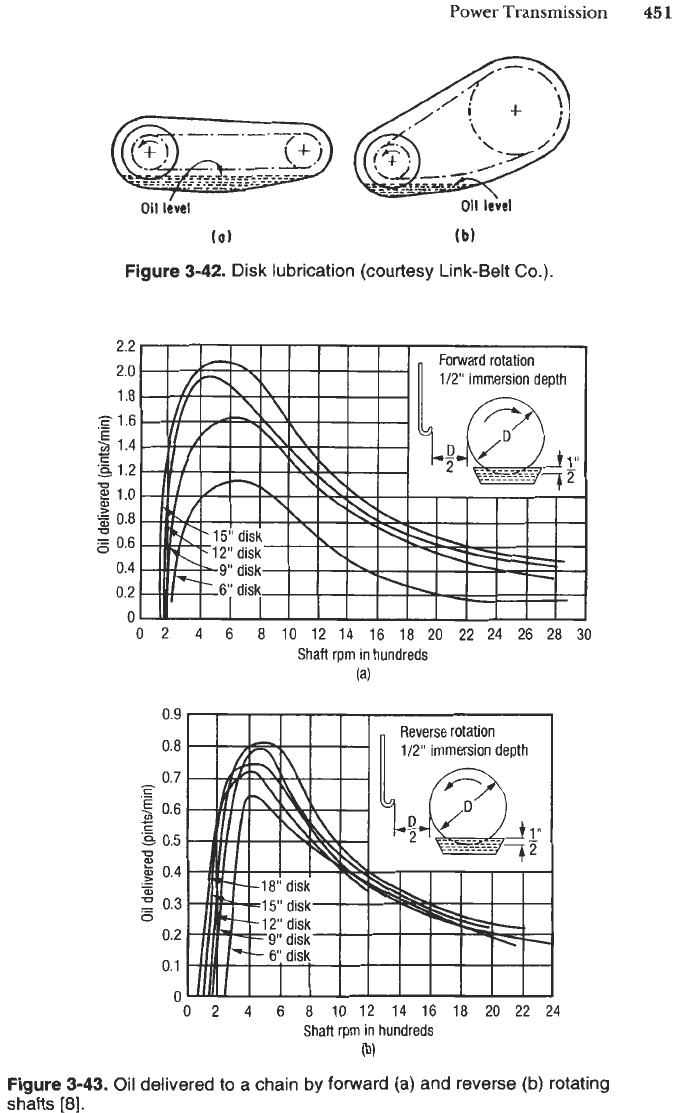
Power
Transmission
45
1
(0)
(b)
Figure
3-42.
Disk
lubrication (courtesy Link-Belt
Co.).
2.2
2.0
1.8
.-
=
1.6
5
1.4
5
1.2
0.8
E
0.6
0.4
0.2
0
c
u
>
U
$
1.0
Forward
rotation
~
0
2
4 6 8 10 12 14 16 18 20 22 24 26 28
30
Shaft
rpm
in
hundreds
(a)
0.9
0.8
0.7
<
0.6
S
0.5
0.4
E
._
0.3
0.2
0.1
n
-
c
.-
Y)
c
c
._
U
(u
.-
-
(u
0
Y
0
2
4
6
8 10 12 14 16 18 20 22 24
Shaft
rpm
in
hundreds
@)
Figure
3-43.
Oil delivered to a chain by forward (a) and reverse (b) rotating
shafts
[8].
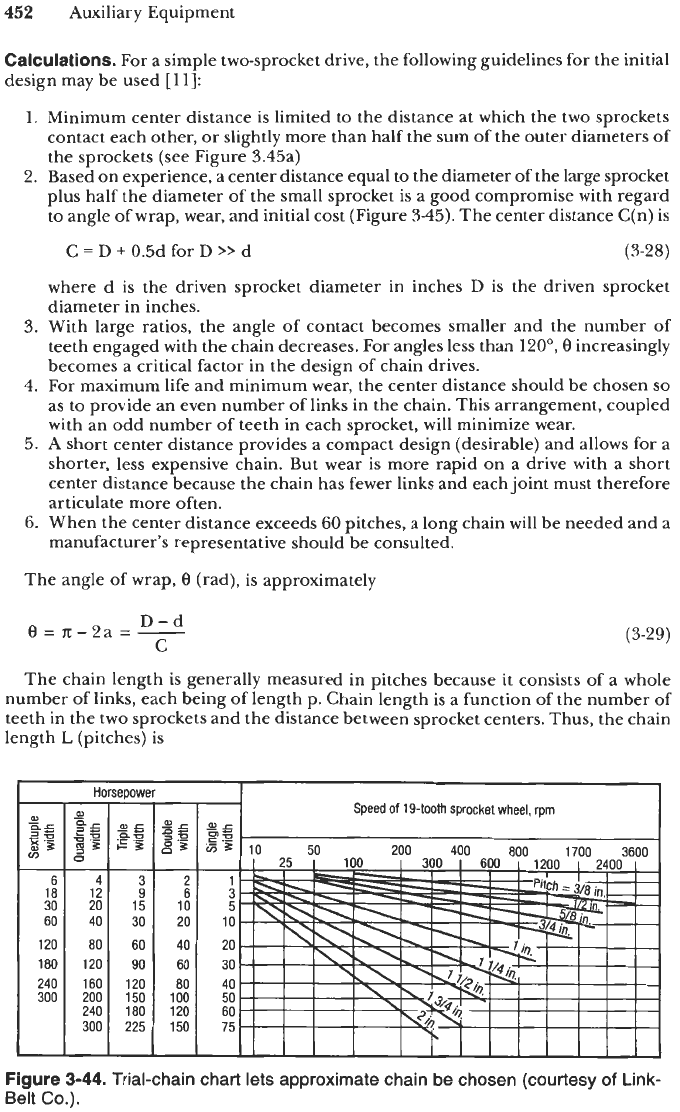
452
Auxiliary Equipment
Calculations.
For a simple two-sprocket drive, the following guidelines for the initial
design may be used
[
111:
1.
2.
3.
4.
5.
6.
Minimum center distance is limited to the distance at which the two sprockets
contact each other,
or
slightly more than half the sum of the outer diameters
of
the sprockets (see Figure 3.45a)
Based on experience, a center distance equal to the diameter of the large sprocket
plus half the diameter of the small sprocket is a good compromise with regard
to
angle of wrap, wear, and initial cost (Figure 345). The center distance C(n) is
C
=
D
+
0.5d for
D
>>
d
(3-28)
where d is the driven sprocket diameter in inches
D
is the driven sprocket
diameter in inches.
With large ratios, the angle of contact becomes smaller and the number of
teeth engaged with the chain decreases. For angles less than
120°,
8
increasingly
becomes a critical factor in the design of chain drives.
For maximum life and minimum wear, the center distance should be chosen
so
as to provide an even number of links in the chain. This arrangement, coupled
with an
odd
number of teeth in each sprocket, will minimize wear.
A
short center distance provides a compact design (desirable) and allows for a
shorter, less expensive chain. But wear
is
more rapid on a drive with a short
center distance because the chain has fewer links and each joint must therefore
articulate more often.
When the center distance exceeds
60
pitches, a long chain will be needed and a
manufacturer’s representative should be consulted.
The angle of wrap,
8
(rad), is approximately
(3-29)
The chain length is generally measured in pitches because it consists of a whole
number of links, each being of length p. Chain length
is
a function of the number of
teeth in the two sprockets and the distance between sprocket centers. Thus, the chain
length
L
(pitches) is
Figure
3-44.
Trial-chain chart lets approximate chain
be
chosen (courtesy
of
Link-
Belt
Co.).
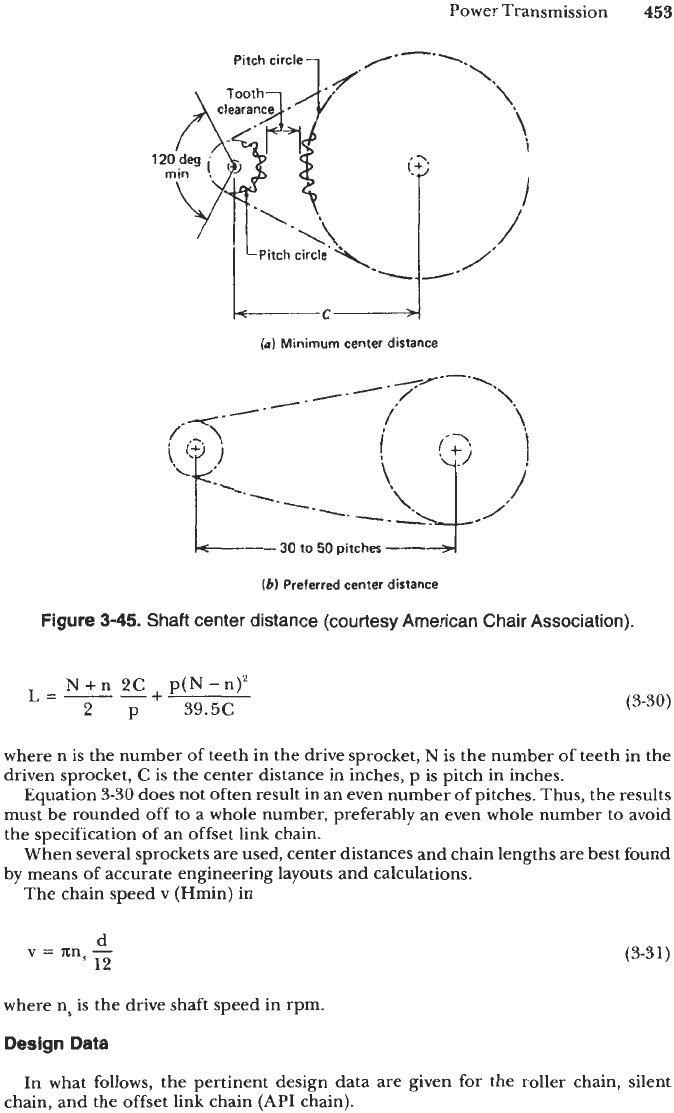
Power Transmission
453
I-Cd
(a)
Minimum
center distance
(b)
Preferred
center distance
Figure
3-45.
Shaft center distance (courtesy American Chair Association).
N+n
2C
+
ptN-n)'
L=--
2
p
39.5c
(5-30)
where n is the number of teeth in the drive sprocket, N
is
the number
of
teeth in the
driven sprocket,
C
is the center distance in inches,
p
is pitch in inches.
Equation
3-30
does not often result in an even number of pitches. Thus, the results
must be rounded off to a whole number, preferably an even whole number to avoid
the specification of an offset link chain.
When several sprockets are used, center distances and chain lengths are best found
by means of accurate engineering layouts and calculations.
The chain speed
v
(Hmin) in
d
v
=
Xn,
-
12
(3-31)
where ns is the drive shaft speed in rpm.
Design
Data
In what follows, the pertinent design data are given for the roller chain, silent
chain, and the offset link chain
(API
chain).
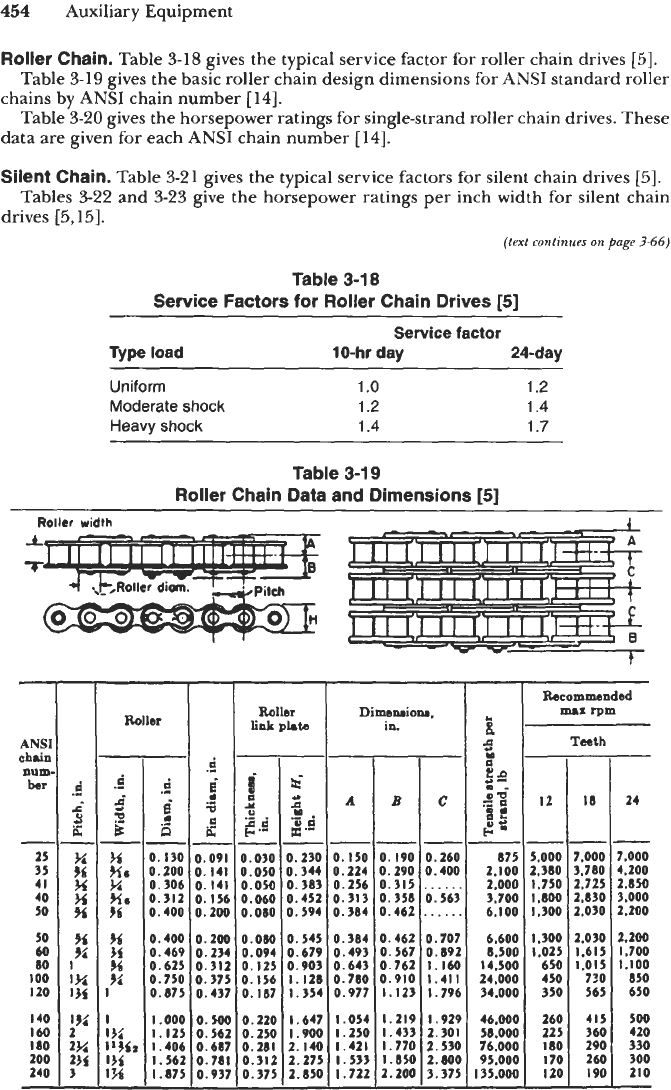
454
Auxiliary Equipment
.d
Bb
54
Fir
%i
HI
36
36
$4
$6
Fi
I
I
IN
1194;
1%
1%
d
%I
Roller Chain.
Table
3-18
gives the typical service factor for roller chain drives
[5].
chains by ANSI chain number
[14].
data are given for each
ANSI
chain number
[
141.
Silent Chain.
Table
3-21
gives the typical service factors for silent chain drives
[5].
drives
[5,15].
Table
3-19
gives the basic roller chain design dimensions for
ANSI
standard roller
Table
3-20
gives the horsepower ratings for single-strand roller chain drives. These
Tables
3-22
and
3-23
give the horsepower ratings per inch width for silent chain
--
0.130
0.200
0.306
0.311
0.400
0.40Q
0.465
0.62!
0.7%
0.87!
1.0ot
1.121
1.404
1.56:
1.871
(lex1
continues
on
page
3-66)
0.030
0.050
0.050
0.060
0.080
Table 3-1
8
Service Factors for Roller Chain Drives
[5]
-----
0.230
0.150
0.190 0.260
0.344
0.224
0.290
0.400
0.313
0.256
0.315
......
0.452
0.313
0.358 0.563
0.594
0.384
0.462
......
Service factor
Type
load
10-hr day 24-day
Uniform
1
.o
1.2
Moderate
shock
1.2 1.4
Heavy
shock
1.4 1.7
875
2.100
2.000
3.700
6.100
6.600
8.500
14.500
24.000
34.000
Table 3-1
9
Roller Chain Data and Dimensions
[5]
5.000
7.000
2.380
3.780
1.750
2.725
1.800
2.830
1.300
2.030
1.300
2.030
1.025
1.615
650 1.015
450
730
350 565
Roller
width
0.080
0.094
0.125
0.156
0.187
0.545
0.384
0.462
0.707
0.679
0.493
0.567
0.192
0.903
0.643
0.762
1.160
1.128
0.780
0.910
1.411
1.354 0.977
1.121
1.796
140
160
I80
240
zoo
d
B
.I
e'
2
-
D.
D9l
1.141
D.
156
m.
141
m.
zw
D.
2M
D.234
D.3li
D.
37!
D.432
D.
m
D.56i
D.68i
0.781
0.93i
-
I)(
2
2%
254
3
Roller
link
phta
1.219
1.433
1.770
1.850
2.200
Dimemiom,
in.
1.929
2.301
2.530
2.800
3.375
46.000
58.000
76.000
95.000
135.000
260
415
225
360
180
290
170
266
120
190
0.120
0.250
0.281
0.312
0.375
-
I.
647
1.900
2.140
2.275
2.850
-
I.
250
I.
421
I.
533
1.722
%commanded
mas
rpm
1
Teeth
ii
24
-
7.000
4.200
2.850
3.000
2.200
2.200
I
.700
1.100
850
650
500
420
330
300
210
